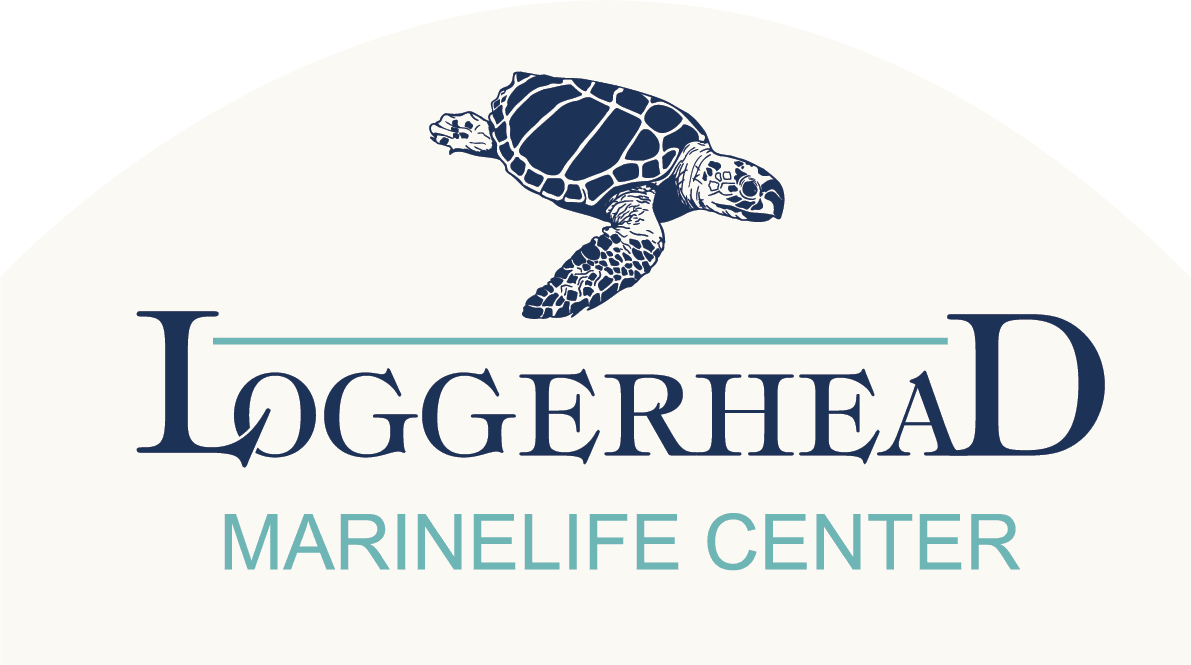- Explore Research -
Sea Turtle Species Profiles
Loggerhead Overview
- Listed as Vulnerable on the IUCN Red List
- Most common sea turtle in Florida
- Named for its large head
- Feeds on crabs, mollusks, encrusting animals attached to reefs and rocks
- Weighs 200 to 350 pounds and measures about 3 feet in length
- Nests in Florida from April through September

Green Turtle Overview
- Listed as Endangered on the IUCN Red List
- Named for greenish color of body fat
- Feeds on seagrass and seaweed
- Adult females weigh 300 pounds and are 3-4 feet in length
- Nests in Florida from May through September
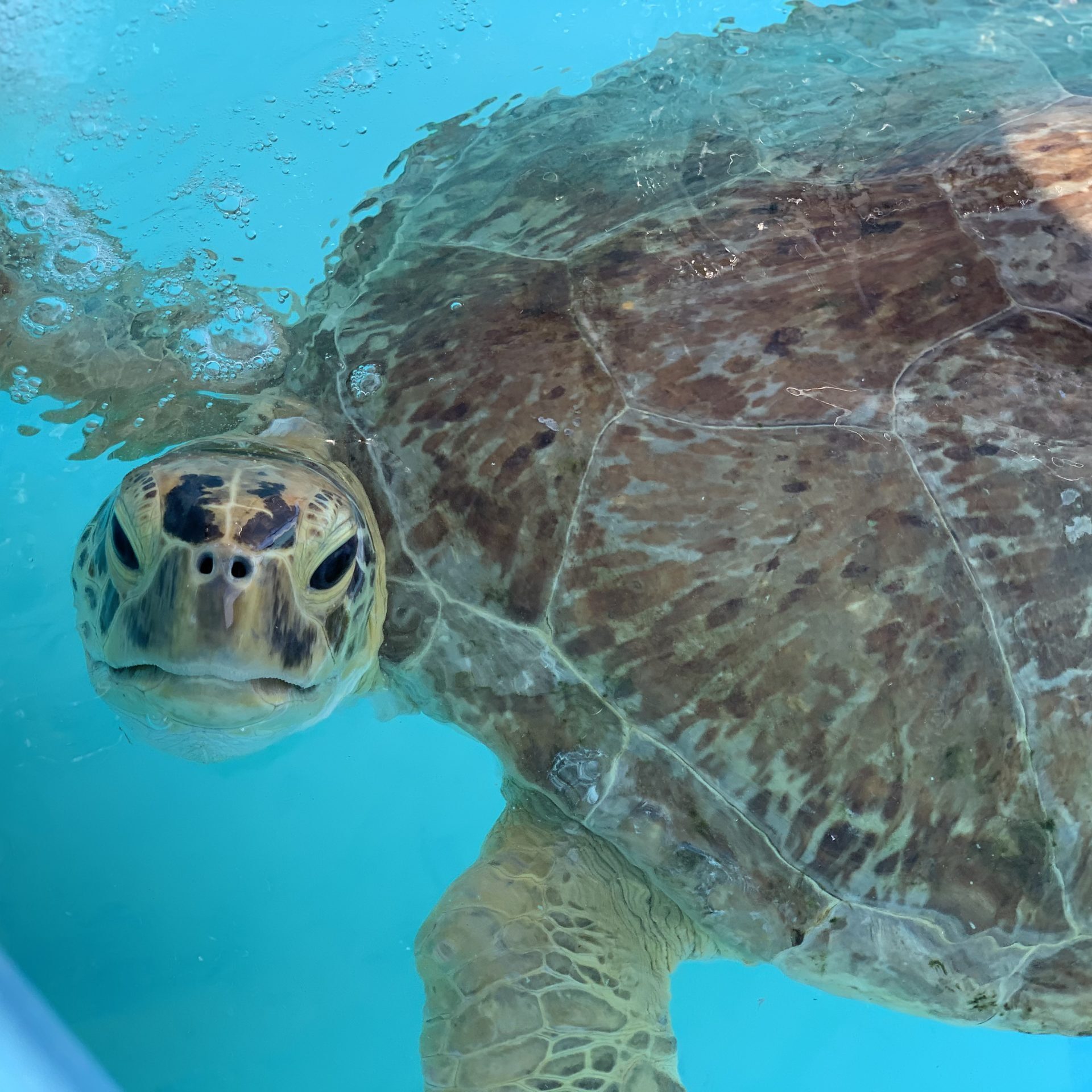
Leatherback Sea Turtle Overview
- Listed as Vulnerable on the IUCN Red List
- Largest and deepest diving of the sea turtles
- Named for smooth, rubbery shell
- Feeds on jellyfish
- Weighs 700-1500 pounds and measures 4 to 8 feet in length
- Nests in Florida from March through July
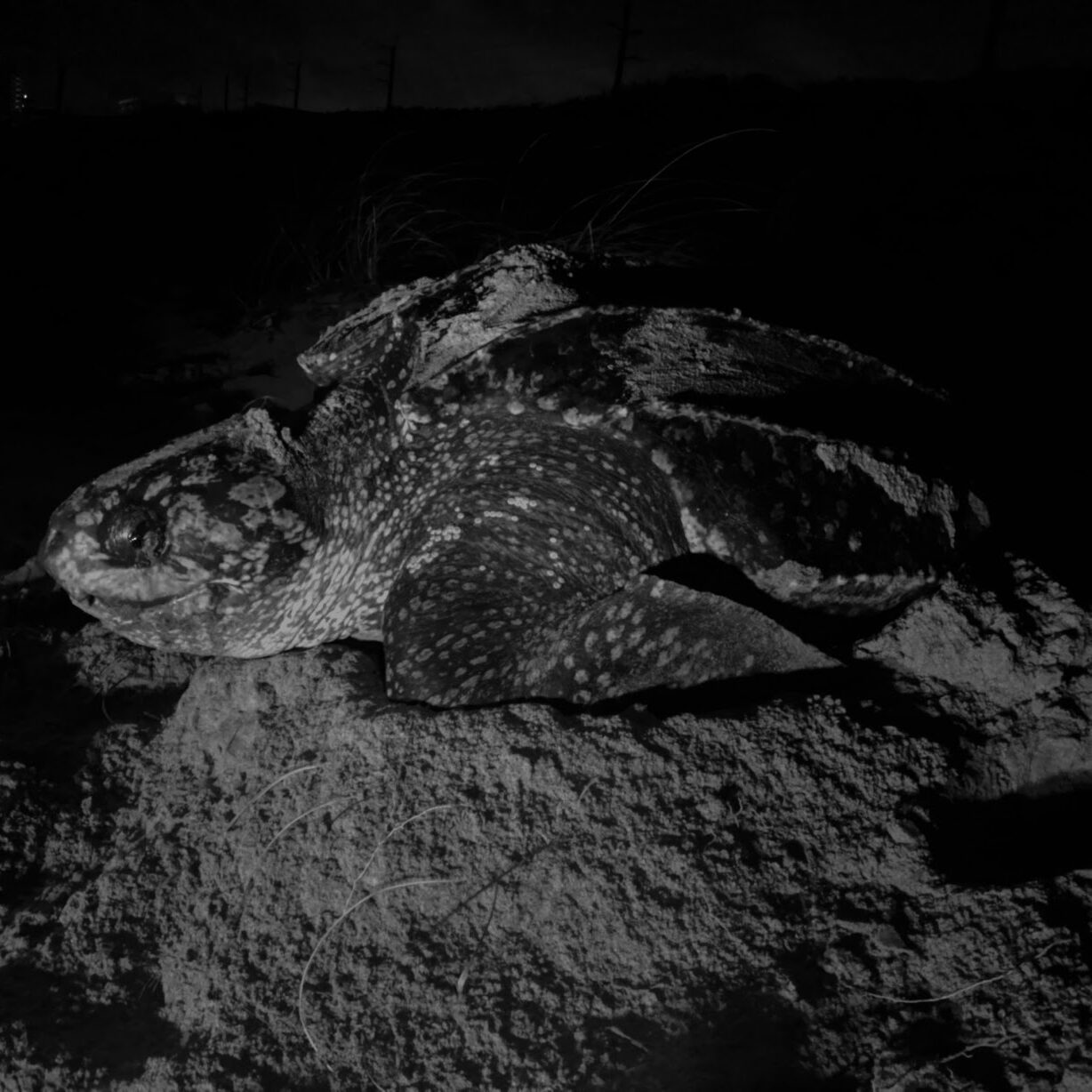
Hawksbill Overview
- Listed as Critically Endangered on the IUCN Red List
- Has a beautiful shell, which is used for jewelry causing this turtle to be listed internationally as critically endangered
- Feeds on sponges
- Occasional nests are found in Palm Beach County each year
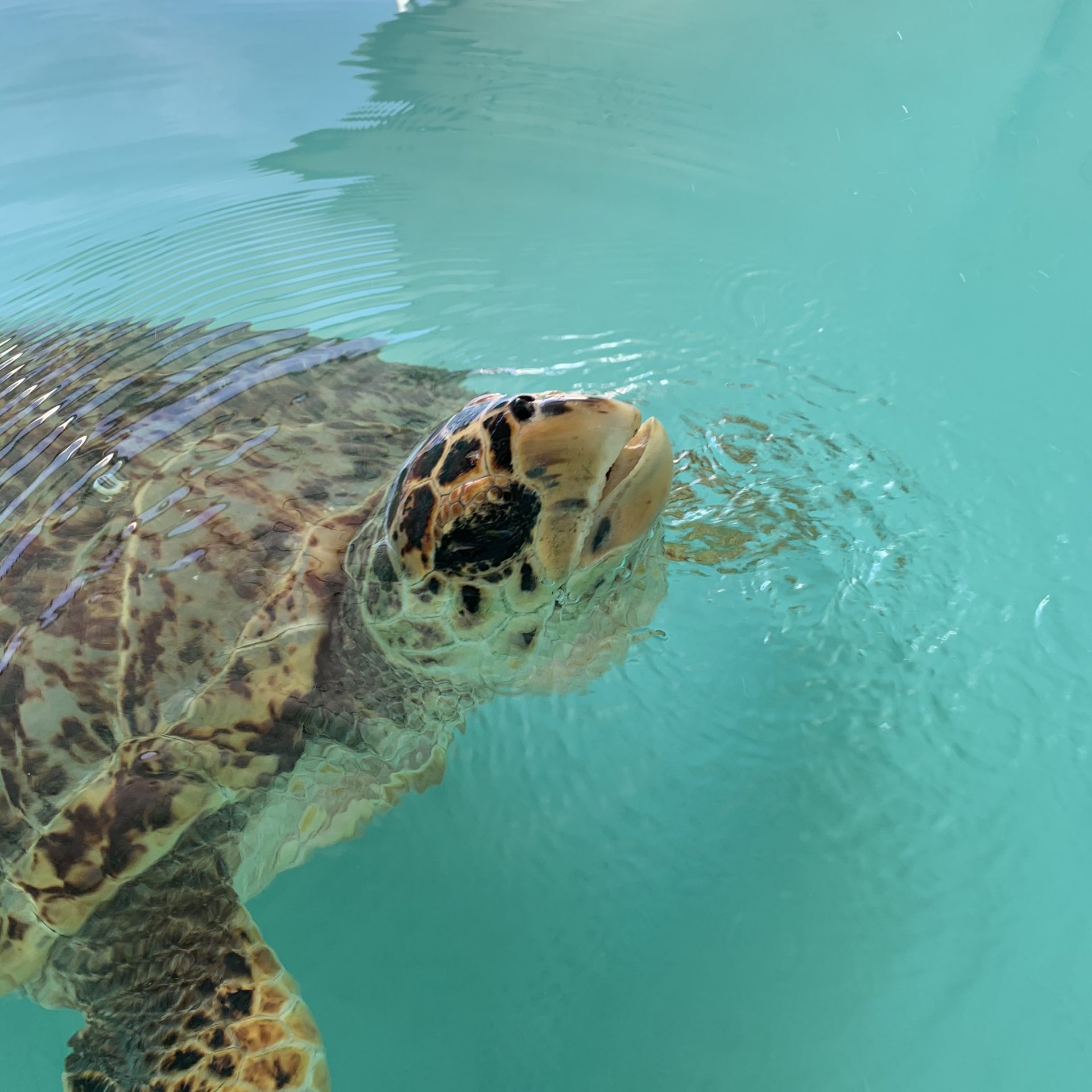
Kemp's Ridley Overview
- Listed as Critically Endangered on the IUCN Red List
- Smallest of the sea turtles
- Nesting is mainly restricted to a 20-mile stretch of beach in western Gulf of Mexico
- Nesting often occurs in large aggregations during the daylight
- Feeds on blue crabs, clams, mussels, fish and jellyfish
- Adult weighs 85-100 pounds and measures 24-30 inches in length
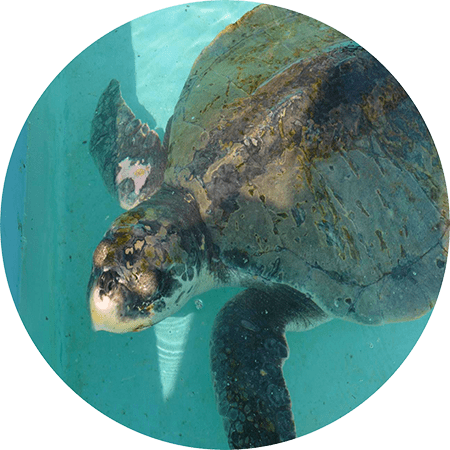
Olive Ridley Overview
- Listed as Vulnerable on the IUCN Red List
- Smallest of the sea turtles
- Turtles are an olive/grayish-green with a heart-shaped carapace
- Feeds on algae, lobster, crabs, tunicates, and mollusks
- Adult weighs up to 100 pounds and measures 24-36 inches in length
Flatback Overview
- Listed as Vulnerable on the Australian Commonwealth’s Endangered Species Protection Act
- Has the smallest geographic range of the seven sea turtle species
- This species lays an average of only 50 eggs per nest, larger hatchlings
- Feeds on sea cucumbers, jellies, soft corals, shrimp, crabs, molluscs, fish, and seaweed
- Adult weighs up to 200 pounds and measures 36 inches in length

Adult - the point in a sea turtle’s life when they reach maturity, some species do not reach adulthood for 25-30 years; all stages of a sea turtle’s life are determined by an international standard of the length of their carapace
Arribadas - Spanish for “arrival by sea;” the synchronized, mass nesting of Kemp’s and olive ridley sea turtles
Blue buttons - a type of planktonic jelly-like animals that are a colony of animal cells, called polyps
Carapace- the upper portion of a turtle’s shell made up of bones and keratinous plates, called scutes
Commensalistic - a relationship between two organisms in which one benefits and the other does not benefit, but remains unharmed
Copepods - microscopic planktonic crustaceans
Epibiota - plants or animals living on the outside of a sea turtle’s shell
Ghost nets - a fishing net that has been lost in the ocean
Hatchling - the first stage of a sea turtle’s life; all stages of a sea turtle’s life are determined by an international standard of the length of their carapace
Hydroids - small predators related to jellies
Invasive species - an organism that is not native to an ecosystem that causes harm
Juvenile - the third stage of a sea turtle’s life, which they reach after post-hatchling, at this phase of their life, juvenile turtles tend to spend time in nearshore habitats; all stages of a sea turtle’s life are determined by an international standard of the length of their carapace
Light pollution - the presence of artificial man-made light
Longline - a type of commercial fishing where there is a main line that has many other lines with baited hooks attached in order to catch fish
Medusavore - a type of carnivore that specifically consumes jellies
Natal beach - the beach a sea turtle hatches from, females will return to this beach once they reach adulthood to nest
Pineal gland - a small structure in the brain that is part of the endocrine system; in leatherback sea turtles it is thought that their pink spot is associated with the pineal gland and their ability to sense light
Planktonic - plants and animals that do not have the ability to swim, but rather float through the ocean, for example, jellies
Post-Hatchling - the second phase of a sea turtle’s life, which they typically spend in floating sargassum mats while growing; all stages of a sea turtle’s life are determined by an international standard of the length of their carapace
Scute - a thickened plate on the back of a sea turtle, made from keratin
Spacer eggs - small unviable, yolkless eggs laid only by leatherback sea turtles
Subadult - the fourth stage of a sea turtle’s life right before they reach adulthood; all stages of a sea turtle’s life are determined by an international standard of the length of their carapace
Trawl - a large net that is pulled behind a boat in order to catch fish or shrimp
Spongivore - a type of carnivore that feeds specifically on sponges
Tunicates - soft-bodied organisms such as sea squirts
Sea Turtle FAQs
- General Questions -
At LMC, we treat sick and injured sea turtles. While there are other kinds of turtles, such as land tortoises or freshwater turtles, our hospital specializes only in the treatment of sea turtles.
There are seven species of sea turtles in the world! The species are as follows: leatherback, green, loggerhead, hawksbill, Kemp's ridley, olive ridley, and Australian flatback. Scroll to the top of this page to learn more!
The names we use are thought up by various means. Some are named after historic figures or holidays, others may be named by the turtle’s rescuer, a generous donor, a staff member, or volunteer.
The patients admitted to The Sea Turtle Hospital at LMC follow a "Rescue-to-Release" protocol. This means that all patients admitted are taken through a treatment and rehabilitation process that aims for their recovery and eventual release back into the wild! We do not keep any patients here permanently. However, if our veterinary staff determines that a patient does not have the ability to be released back into the wild based on its condition, we will make arrangements for the animal to be transferred to another facility that hosts resident animals.
In order to prepare our patients for eventual release back into the wild, our hospital staff takes all necessary precautions to reduce the amount of human interaction, especially in association with food. For this reason, we typically feed the patients before and after public hours to our facility. Common food items on our hospital's menu include fish, squid, crab or lobster, and a variety of greens like lettuce or green pepper.
At our facility, the sea turtles are medical patients and each patient requires different care regimens and treatments, so it is best to keep them separated - similar to how patients in a human hospital may share a room but have separate hospital beds. In addition, sea turtles in the wild are considered to be solitary rather than social animals, therefore we provide them their own space while they are in our care.
It is unlawful to touch, handle, or otherwise harass sea turtles. The sea turtle is an endangered species that is protected by state and federal regulations. As a rehabilitation facility, our trained hospital staff and volunteers are permitted to properly handle the sea turtle patients for the purposes of treatment and rehabilitation only. In the wild, it is unlawful to touch or otherwise harass a sea turtle and it is best practice to view wildlife from 150 feet or greater in distance.
With sea turtles, the frequency of breathing can depend on size, medical condition, and activity level - for example, the larger turtles can typically spend more time underwater than the smaller ones, and a turtle that is more highly active will need to breathe more frequently.
As sea turtles grow in size, their predators change. The eggs of sea turtles can be a meal for foxes, raccoons, crabs, and other small carnivores. As hatchlings, their predators include birds, rodents and small carnivores, insects, and fish. As they grow into adults, their biggest natural predators are sharks. They also face threats from human impacts, both intentional and unintentional. Humans illegally harvest sea turtles for their meat, flippers and shells - called poaching. Many sea turtles are also impacted by unintentional commercial fishing techniques, and ever-developing coastlines disrupt nesting and hatch success.
It is hard to know for sure, but researchers estimate that approximately 1 in 1,000 to 1 in 10,000 eggs produce hatchlings that reach adulthood.
The age of a sea turtle is an estimate based on the size of an animal, and it can vary between species. Researchers estimate that sea turtles can live to be over 80-100 years old!
In March of 2021, The Sea Turtle Hospital at LMC received the oldest and largest loggerhead patient that it had ever treated. Olmec, an adult male loggerhead sea turtle weighed over 358 pounds. Although we do not know the exact age, from the size of the turtle it was estimated that he was over 100 years old. Olmec underwent extensive, 24/7 medical therapy for pneumonia and a systemic infection but unfortunately passed overnight in our care. Treating Olmec has given our veterinary team significant insight into the largely unknown fields of geriatric sea turtle medicine and hospice care. It was truly an honor to treat this very old member of this ancient species.
Artificial lighting disrupts the nesting process of female sea turtles, and is one of the biggest threats for emerging hatchlings. Both hatchlings and nesting sea turtles rely on natural lighting such as moonlight to navigate their surroundings and find their way to the ocean, and artificial lighting can result in the turtles becoming disoriented. Disoriented hatchlings can fall victim to dehydration, loss of energy, and predation. By turning off lights at night, closing curtains, and avoiding any activity on the beach at night, you can help nesting turtles and hatchlings!
- Rescue -
Our patients arrive at our hospital in a variety of ways. In some cases, our rehabilitation team will actively rescue and recover a sick or injured sea turtle and transport them to our hospital in our sea turtle ambulance! The Florida Fish and Wildlife Conservation Commission (FWC) will also transfer patients that they have locally rescued to our Sea Turtle Hospital at LMC. During nesting season, sea turtle hatchlings are often brought to us by members of the community that may find sick or injured hatchlings on the beach or along the coastline. See “Found a Sick or Injured Sea Turtle” for more information!
If you have found an injured, deceased, or harassed Sea Turtle, or to report someone disturbing a sea turtle nest: Call: 1-888-404-FWCC (3922) - Cellular phone *FWC or #FWC
If you ever happen to come in contact with an injured or stranded sea turtle please call Florida Fish and Wildlife Conservation Commission (FWC) immediately at 1-888-404-FWCC (3922) or you may dial *FWC or #FWC on your mobile phone.
Once you have contacted FWC you are also welcome to call the center at our 24 hour Emergency Response number (561-603-0211
) if you are in need of assistance with the rescue. If a sick or injured turtle is observed at sea, please contact FWC directly and follow their instructions. Do not attempt to rescue the injured sea turtle as this could result in further injury to the animal or the rescuer.
If you are on a pier and a turtle is caught on a hook, contact Loggerhead Marinelife Center's 24 Hour Sea Turtle Rescue Line at (561) 603-0211 or FWC. See “Found a Sick or Injured Sea Turtle” for more information!
The Sea Turtle Hospital at LMC has admitted close to 2,000 sea turtles since opening in 1990. Each year, we typically receive over 100 patients. In 2019, we treated 153 sea turtle patients and in 2020 we treated 113!
- Rehabilitation -
Harmful boat interactions are one of the most common reasons for strandings in this area. Propeller-related trauma can damage any part of the turtle, and serious, permanent injury from motorcraft encounters can result in partial or full paralysis, buoyancy disorders, GI disease, and chronic debilitation. A turtle can become chronically debilitated because of several factors, all of which inhibit feeding or nutrient absorption, resulting in starvation. Check out LMC’s Responsible Boating Initiative.
Daily medical treatments are performed in both the indoor and outdoor hospitals. Within the walls of the indoor hospital, we have a bloodwork laboratory, radiology suite, surgical suite, endoscopy and ultrasound, pharmacy and treatment room. We often perform treatments inside a drained tank if the patient is large and to reduce the stress of daily transportation to the indoor hospital.
We do not collect eggs to incubate, and we do not raise hatchlings for release - all of the sea turtles, regardless of age, that pass through the hospital are here for medical treatment and rehabilitation. They are here until medically cleared for release, when they are returned to the wild.
Most of the time, sea turtles are able to pass the plastics (or other foreign material) on their own with the help of treatment while in our hospital. In some severe cases, our veterinary staff may need to perform surgery to remove the foreign object(s). Based on our clinical studies, we estimate that 100% of hatchlings encounter or at risk of ingesting plastic during their first year of life.
There are no sea turtle-specific medications at this time. Most hospitals use adapted doses of human medicine or other veterinary medicines (like those for cats, dogs, or even horses). Our hospital contributes important information in the study of medications in sea turtles, we are always learning something new!
Sea turtles often mistake trash in the ocean as food items, or unintentionally ingest the debris while eating normal food items. They can also become entangled in debris like monofilament line, fishing nets, and rope. The turtle may also not be able to swim and dive while entangled in the debris, preventing them from feeding normally or evading predators.
- Release -
All of our sea turtle patients (with the exception of hatchlings and post-hatchlings) receive two types of tags: metal flipper tags with a unique identifier (serial number) and a PIT tag similar to a microchip. On occasion, some of our larger patients that may receive satellite tracking tags which allow us to follow their movements for a limited time after release.
The goal for all admitted patients to the Sea Turtle Hospital at LMC is for them to be released back into the wild following successful rehabilitation. In some cases, despite all efforts, a patient is determined to be non-releasable by our veterinary staff and depending on the condition of the animal, may be transferred to another facility.
Our veterinary team determines when a patient is medically ready for release based on its health progress. Typically, the patient will have to be a healthy weight and be gaining weight at a normal rate, have normal bloodwork, and be off of all medications for several weeks. The hospital team will then work with the Florida Fish and Wildlife Conservation Commission (FWC) to determine a date and location for the release based on environmental conditions and the natural behavior of the species at its age class.
Our veterinary team determines when a patient is medically ready for release based on its health progress. Typically, the patient will have to be a healthy weight and be gaining weight at a normal rate, have normal bloodwork, and be off of all medications for several weeks. The hospital team will then work with the Florida Fish and Wildlife Conservation Commission (FWC) to determine a date and location for the release based on environmental conditions and the natural behavior of the species at its age class.
The releases of our larger subadult and adult patients are often public releases that you can attend! Our smaller patients, like the juveniles and hatchlings, are privately released or taken offshore and released by boat. Check out our social media channels for live broadcasts and videos of our releases on Facebook, Instagram, and YouTube!
- Nesting Research -
There are primarily three species that nest on our beaches in southeast Florida: the leatherback sea turtle, green sea turtle, and loggerhead sea turtle. Learn more about each species!
Sea turtle nesting season in southeast Florida runs from March 1st to October 31st.
LMC has a highly trained research team of scientists who patrol 9.5 miles of beach from the northern border line of John D. MacArthur Beach State Park (southern extent of survey area) to the Martin County line during nesting season. Dawn nesting surveys are conducted daily from March 1 - October 31 each year, and serve to collect information regarding crawl counts, nest numbers, and reproductive success from three species of sea turtle nesting on our beaches!
The number of eggs in a nest can vary by species, and ranges from an average of 80 - 120 eggs in each clutch (nest).
Sea turtles have what is called “temperature-dependent sex determination”, or TSD, which means that the temperature at which the eggs incubate determines the gender of the hatchlings. In sea turtles, warmer nest temperatures produce more females, and cooler nest temperatures produce more males. There can be a mix of both males and females in one nest!
Nests that we have discovered are all documented by GPS location. However, due to the high nest density on our beaches, only a portion of them are distinguished with a physical marker. Nests that are selected to be evaluated for hatch success will be identified with a wooden stake with a unique ID for accurate tracking and reporting.
While sea turtles are beautiful, captivating creatures, it is illegal to harm or harass sea turtles, their nests or hatchlings. Sea turtles are protected by the US Endangered Species Act of 1973 and Florida Statute Chapter 370.
Don’t:
- Don’t interact with or disrupt a nesting sea turtle
- Don’t use lighting on the beach at night including flash photography, or cell phones
- Don’t touch hatchlings on their way to the ocean
- Don’t take any action for empty egg shells, or exposed, un-hatched eggs
- Don’t harm or harass sea turtles, their nests or hatchlings
- Don’t use shovels to dig on the beach during nesting season
Adopt A Sea Turtle
You can support Loggerhead Marinelife Center by “adopting” a sea turtle patient starting at just $40. Your adoption directly benefits the continued care and treatment of our sick and injured sea turtles!
